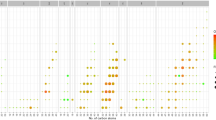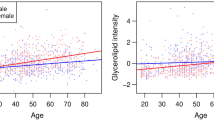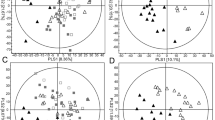Abstract
We investigated alterations in plasma metabolites associated with the age-related increase in circulating concentration of low-density lipoprotein (LDL)-cholesterol. The study included 602 healthy, nondiabetic subjects (aged 30–65 years). Among 393 individuals with LDL-cholesterol within the normal limit at baseline, 56 (14.2 %) developed high fasting LDL-cholesterol levels after 3 years. The 337 subjects that retained normal LDL-cholesterol were matched for age, gender, BMI, and fasting LDL-cholesterol to form the control group (n = 78). At the 3-year follow-up, the high-LDL group showed greater increases in serum total-cholesterol and LDL-cholesterol, plasma oxidized LDL, lipoprotein-associated phospholipase A2 activity, and urinary 8-epi-prostaglandin F2α than the control group after adjusting for baseline levels. The high-LDL group also showed significant decreases in sphingomyelin (SM) (d18:0/16:1) and phosphatidylcholine (PC) (18:0/20:4), which were associated with an increases on LDL-cholesterol, and significant increases in palmitic amide and lactosylceramide. Mean changes in the levels of SM (d18:0/16:1), C17 sphinganine, PC (18:0/20:4), and eight lysoPCs containing C16:1, C16:0, C17:0, C18:1, C18:0, C20:4, C20:3, and C22:6 were statistically different between control and high-LDL groups. Overall, the change in ox-LDL positively correlated with changes in LDL-cholesterol, Lp-PLA2 activity, palmitic amide, oleamide, lysoPCs, and C17 sphinganine, and negatively correlated with changes in SM (d18:0/16:1) (r = −0.501, P < 0.001). An age-related increase in LDL-cholesterol is associated with enhanced oxidative stress and disturbed sphingolipid metabolism.


Similar content being viewed by others
References
Anderson, K. M., Wilson, P. W., Odell, P. M., & Kannel, W. B. (1991). An updated coronary risk profile. A statement for health professionals. Circulation, 83(1), 356–362.
Asciutto, G., Edsfeldt, A., Dias, N. V., Nilsson, J., Prehn, C., Adamski, J., et al. (2013). Treatment with beta-blockers is associated with lower levels of Lp-PLA2 and suPAR in carotid plaques. Cardiovascular Pathology, 22(6), 438–443.
Chakraborti, S. (2003). Phospholipase A(2) isoforms: A perspective. Celluar Signalling, 15(7), 637–665.
Chen, Q., & Reimer, R. A. (2009). Dairy protein and leucine alter GLP-1 release and mRNA of genes involved in intestinal lipid metabolism in vitro. Nutrition, 25(3), 340–349.
D’Agostino, R. B., Sr, Grundy, S., Sullivan, L. M., & Wilson, P. (2001). Validation of the Framingham coronary heart disease prediction scores: Results of a multiple ethnic groups investigation. Journal of the American Medical Association, 286(2), 180–187.
D’Agostino, R. B., Russell, M. W., Huse, D. M., Ellison, R. C., Silbershatz, H., Wilson, P. W., et al. (2000). Primary and subsequent coronary risk appraisal: New results from the Framingham study. The American Heart Journal, 139(2), 272–281.
De Guzman, J. M., Ku, G., Fahey, R., Youm, Y. H., Kass, I., Ingram, D. K., et al. (2013). Chronic caloric restriction partially protects against age-related alteration in serum metabolome. Age, 35(4), 1091–1104.
Egom, E. E., Mamas, M. A., Chacko, S., Stringer, S. E., Charlton-Menys, V., El-Omar, M., et al. (2013). Serum sphingolipids level as a novel potential marker for early detection of human myocardial ischaemic injury. Frontiers in Physiology, 4, 130.
Expert Panel on Detection, Evaluation, and Treatment of High Blood Cholesterol in Adults. (2001). Executive summary of the third report of The National Cholesterol Education Program (NCEP) expert panel on detection, evaluation, and treatment of high blood cholesterol in adults (Adult Treatment Panel III). Journal of the American Medical Association, 285(19), 2486–2497.
Ezzili, C., Otrubova, K., & Boger, D. L. (2010). Fatty acid amide signaling molecules. Bioorganic & Medicinal Chemistry Letters, 20(20), 5959–5968.
Farrell, E. K., Chen, Y., Barazanji, M., Jeffries, K. A., Cameroamortegui, F., & Merkler, D. J. (2012). Primary fatty acid amide metabolism: Conversion of fatty acids and an ethanolamine in N18TG2 and SCP cells. Journal of Lipid Research, 53(2), 247–256.
Gold, M., & Altschuler, H. (1972). Red blood cell and plasma phospholipids in aged humans. Journal of Gerontology, 27(4), 444–450.
Gong, N., Wei, H., Chowdhury, S. H., & Chatterjee, S. (2004). Lactosylceramide recruits PKCalpha/epsilon and phospholipase A2 to stimulate PECAM-1 expression in human monocytes and adhesion to endothelial cells. Proceedings of the National Academy of Sciences of the United States of America, 101(17), 6490–6495.
Herman, M. A., She, P., Peroni, O. D., Lynch, C. J., & Kahn, B. B. (2010). Adipose tissue branched chain amino acid (BCAA) metabolism modulates circulating BCAA levels. Journal of Biological Chemistry, 285(15), 11348–11356.
Kono, N., Inoue, T., Yoshida, Y., Sato, H., Matsusue, T., Itabe, H., et al. (2008). Protection against oxidative stress-induced hepatic injury by intracellular type II platelet-activating factor acetylhydrolase by metabolism of oxidized phospholipids in vivo. Journal of Biological Chemistry, 283(3), 1628–1636.
Kougias, P., Chai, H., Lin, P. H., Lumsden, A. B., Yao, Q., & Chen, C. (2006). Lysophophatidylcholine and secretory phospholipase A2 in vascular disease: mediators of endothelial dysfunction and atherosclerosis. Medical Science Monitor, 12(1), RA5-16.
Kurowska, E. M., & Carroll, K. K. (1994). Hypercholesterolemic responses in rabbits to selected groups of dietary essential amino acids. Journal of Nutrition, 124(3), 364–370.
Lin, L., Huang, Z., Gao, Y., Chen, Y., Hang, W., Xing, J., et al. (2012). LC-MS-based serum metabolic profiling for genitourinary cancer classification and cancer type-specific biomarker discovery. Proteomics, 12(14), 2238–2246.
Malhotra, S., & Kritchevsky, D. (1978). The distribution and lipid composition of ultracentrifugally separated lipoproteins of young and old rat plasma. Mechanisms of Ageing and Development, 8(6), 445–452.
Matsumoto, T., Kobayashi, T., & Kamata, K. (2007). Role of lysophosphatidylcholine (LPC) in atherosclerosis. Current Medicinal Chemistry, 14(30), 3209–3220.
National Cholesterol Education Program (NCEP) Expert Panel on Detection, Evaluation, and Treatment of High Blood Cholesterol in Adults (Adult Treatment Panel III). (2002). Third report of the National Cholesterol Education Program (NCEP) expert panel on detection, evaluation, and treatment of high blood cholesterol in adults (Adult Treatment Panel III) final report. Circulation, 106(25), 3143–3421.
Nilsson, A., & Duan, R. D. (2006). Absorption and lipoprotein transport of sphingomyelin. Journal of Lipid Research, 47(1), 154–171.
Rajesh, M., Kolmakova, A., & Chatterjee, S. (2005). Novel role of lactosylceramide in vascular endothelial growth factor-mediated angiogenesis in human endothelial cells. Circulation Research, 97(8), 796–804.
Shah, S. H., Crosslin, D. R., Haynes, C. S., Nelson, S., Turer, C. B., Stevens, R. D., et al. (2012). Branched-chain amino acid levels are associated with improvement in insulin resistance with weight loss. Diabetologia, 55(2), 321–330.
Stafforini, D. M., Sheller, J. R., Blackwell, T. S., Sapirstein, A., Yull, F. E., McIntyre, T. M., et al. (2006). Release of free F2-isoprostanes from esterified phospholipids is catalyzed by intracellular and plasma platelet-activating factor acetylhydrolases. Journal of Biological Chemistry, 281(8), 4616–4623.
Steinberg, D. (2002). Atherogenesis in perspective: Hypercholesterolemia and inflammation as partners in crime. Nature Medicine, 8(11), 1211–1217.
Subbaiah, P. V., Jiang, X. C., Belikova, N. A., Aizezi, B., Huang, Z. H., & Reardon, C. A. (2012). Regulation of plasma cholesterol esterification by sphingomyelin: Effect of physiological variations of plasma sphingomyelin on lecithin-cholesterol acyltransferase activity. Biochimica et Biophysica Acta, 1821(6), 908–913.
Williams, R., Lenz, E. M., Wilson, A. J., Granger, J., Wilson, I. D., Major, H., et al. (2006). A multi-analytical platform approach to the metabonomic analysis of plasma from normal and Zucker (fa/fa) obese rats. Molecular BioSystems, 2(3–4), 174–183.
Wilson, P. W., D’Agostino, R. B., Levy, D., Belanger, A. M., Silbershatz, H., & Kannel, W. B. (1998). Prediction of coronary heart disease using risk factor categories. Circulation, 97(18), 1837–1847.
Zhang, Y., Guo, K., LeBlanc, R. E., Loh, D., Schwartz, G. J., & Yu, Y. H. (2007). Increasing dietary leucine intake reduces diet-induced obesity and improves glucose and cholesterol metabolism in mice via multimechanisms. Diabetes, 56(6), 1647–1654.
Acknowledgments
Sample collection and experiments were performed by S. J., M. K., H. J. R., J. S. C., S-H. L., and J. H. L. Data were analyzed by S. J., M. K, and J. H. L. J. H. L. provided the research funding and S. J., M. K., and J. H. L. wrote the manuscript. All of the authors read, commented on, and contributed to the submitted manuscript. No potential conflicts of interest relevant to this article were reported. The authors thank the research volunteers who participated in the studies described in this article and the technical assistants of Yonsei Center for Research Facilities, Yonsei University, for data generation of LC–MS (LTQ Orbitrap (micro-LC)). This research was supported by the Bio and Medical Technology Development Program (NRF-2006-2005306 and NRF-2012M3A9C4048762) and Mid-career Researcher Program (NRF-2010-0015017) of the National Research Foundation (NRF) funded by the Ministry of Science, ICT & Future Planning, Republic of Korea.
Conflict of interest
None of the authors have a conflict of interest relevant to this work.
Ethical standards
All procedures followed were in accordance with the ethical standards of the responsible committee on human experimentation (institutional and national) and with the Helsinki Declaration of 1975, as revised in 2000. Informed consent was obtained from all participants for being included in the study.
Author information
Authors and Affiliations
Corresponding author
Electronic supplementary material
Below is the link to the electronic supplementary material.
Rights and permissions
About this article
Cite this article
Jung, S., Kim, M., Ryu, H.J. et al. Age-related increase in LDL-cholesterol is associated with enhanced oxidative stress and disturbed sphingolipid metabolism. Metabolomics 11, 40–49 (2015). https://doi.org/10.1007/s11306-014-0669-3
Received:
Accepted:
Published:
Issue Date:
DOI: https://doi.org/10.1007/s11306-014-0669-3




